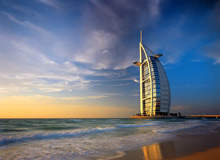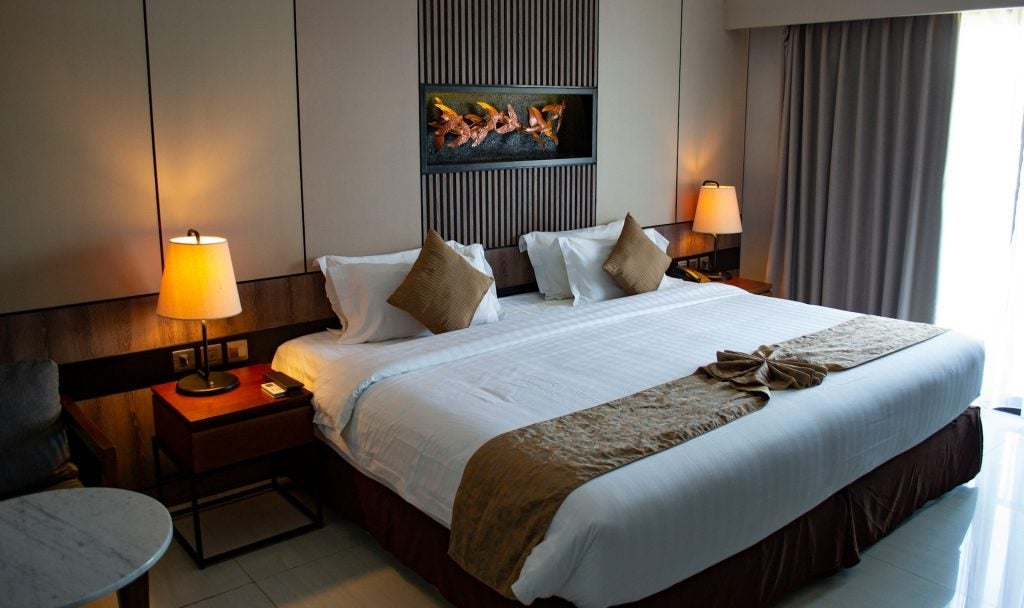
It used to be petrodollars that drove the economies of Middle East countries; today it’s tourism.
The region is the fourth most visited in the world, its air passenger traffic is growing faster than anywhere else, and Dubai, the powerhouse of the Gulf, is widely regarded as the fastest- growing city.
Around 80 hotels are expected to open on the Arabian Peninsular within three years, easily the fastest expansion on record, and although parts of the Middle East now resemble building sites, with cranes filling the skylines, the region’s popularity continues to grow.
HIGH HOPES
We’ve become accustomed to using superlatives when we mention the Middle East and tourism in the same breath – whatever it is, it’s usually the largest, the highest, the most luxurious or the fastest growing.
It’s the same when it comes to hotel performance, with Dubai enjoying some of the world’s highest average room rates.
How well do you really know your competitors?
Access the most comprehensive Company Profiles on the market, powered by GlobalData. Save hours of research. Gain competitive edge.

Thank you!
Your download email will arrive shortly
Not ready to buy yet? Download a free sample
We are confident about the unique quality of our Company Profiles. However, we want you to make the most beneficial decision for your business, so we offer a free sample that you can download by submitting the below form
By GlobalDataThis situation is unlikely to change in the short term, particularly as the Gulf States of Dubai, Abu Dhabi, Qatar and Bahrain continue to pump millions of dollars into upgrading their airports and investing in global advertising.
Hotels in the Middle East have seen impressive growth in recent years; in the last two years, the region has outperformed both Asia and Europe.
However, results from the HotelBenchmark™ Survey by Deloitte show that the rate of growth has started to slow. During the first quarter of 2006, revPAR increased by 11%. While this still represents strong growth, it is nonetheless some way off the remarkable 30 and 20% growth seen in 2004 and 2005, respectively.
Despite a slight dip in occupancy levels, average room rates are still growing. During the first quarter of 2006, these increased by 15% to $142, resulting in a revPAR of $96, pushing the performance of hotels in the Middle East ahead of the USA by $38 and Europe by $21.
Many travellers are drawn to this part of the world, attracted by the year-round sunshine, huge shopping malls, high-quality accommodation and relaxed attitude to Western lifestyles.
SPORT AID
There is also the magnet of top-class sport, with many Middle East countries using major sporting events to propel themselves into the arena of global tourism.
Dubai has been quick to recognise the added value of sports tourism. Having staged the world’s wealthiest equestrian event, the Dubai Cup, for many years, its sporting calendar has quickly filled up to take in golf, tennis, camel racing, rugby, international powerboat racing and the Dubai Air Show.
It is now building on this success with the Dubai Sports City, which will include a sports stadium, academies, a golf course and plenty of luxurious accommodation.
Since its first race in 2004, Bahrain has basked in the reflected glory of Formula One, attracting thousands of spectators and millions of TV viewers.
This year, it’s Doha’s chance to shine, as it hosts the Asian Games – second only to the Olympics as a global multi-sport event.
During the first two weeks of December, 10,500 athletes and team officials from 45 countries across Asia will descend on Doha to compete in 40 sports events. The Games has resulted in a raft of multi-million dollar projects to bring Doha’s infrastructure up to international standards, including new roads, hotels and leisure facilities.
Qatar Airways is running a promotional campaign introducing a fleet of 2006 Games branded aircraft, carrying the message ‘Let the Spirit Move You’.
It is the fastest-growing airline in the world, and will soon be adding New York and Melbourne to its list of destinations, bringing the total to 80.
Earlier this year, it launched non-stop daily flights to Hong Kong, its 12th destination in the Far East. The country’s new international airport is due to open in 2009, handling around 12 million passengers a year in its first phase.
All the major airports in the region are upgrading. Dubai International is undergoing a $4bn expansion, and a new six-runway airport is being built on the west side of the city.
Meanwhile, established regional carriers such as Emirates Airlines and Gulf Air have been expanding aggressively, placing multi-billion dollar orders to expand their fleets.
INCREASED MARKET SHARE
These revamped and extended airport facilities will be essential if the predictions of the World Tourism Organisation (UNWTO) prove correct. The UNWTO estimated that the Middle East attracted 38 million tourists during 2005, up 7% on the year before.
This increase pushed the region’s share of the global travel market up to almost 5%, and the trend is expected to continue; the UNTWO predicts that the region will see an average annual growth rate of 7% – the highest in the world – resulting in 68.5 million international arrivals by 2020.
Currently, around six million tourists a year visit Dubai, and the government wants to more than double this figure to 15 million by 2010. The country is particularly popular with Europeans, especially visitors from the UK, who make up a third of all visitors.
However, the number of travellers from Saudi Arabia shot up by a third in 2005, and intraregional travel is becoming increasingly important.
Arab visitors, for instance, are at the heart of the Nawart Masr (you light up Egypt) campaign, which is expected to attract more Middle Eastern tourists to the land of the pharaohs.
Arab tourists will also be encouraged to visit Sri Lanka and India when Sri Lankan Airlines adds more direct flights to its Middle East destinations.
Saudi Arabia, however, would prefer people to stay at home. With four million pilgrims visiting Mecca every year, religious tourism remains the country’s number one focus, but it wants to bring back some of the $8bn Saudis spend travelling abroad.
In 2005, Riyadh staged its first ever summer festival, replicating the success of Dubai’s annual shopping event and attracting thousands of local visitors. The country now wants to explore similar ideas.
TOP PERFORMERS
With so much happening in Dubai, it’s not surprising that it continues to boast the highest occupancy and average room rates in the region.
Although first-quarter figures showed occupancy dipping slightly to 87% compared with the same period the year before, average room rates increased by 19%.
This meant that, at $286, average room rates in Dubai are among the world’s highest, ahead of leading destinations such as New York, London and Paris.
The pace of new openings in Dubai continued in 2005, but with most of these at the luxury end of the market there is still room for expansion in the mid-market and budget sectors.
Keen to take advantage of these opportunities, both Premier Travel Inn and easyHotel have recently announced plans to develop hotels in the market.
Dubai’s success seems to be rubbing off on its neighbours. In Abu Dhabi there has been a rapid increase in the number of new hotel openings, backed by the country’s tourist board.
During the first quarter of 2006, the market saw the highest growth in average room rates in the region. These increased by 41% to $157, the result a number of exhibitions and conferences being hosted in the city.
Although occupancy figures in the city were not so healthy – down 11% – the country’s expanding airline, Etihad Airways, which now flies to 30 different destinations, may help to boost this figure later on this year.
Its neighbour, Doha, managed to push average room rates up by 28% to $240, second only to Dubai.
With a huge influx of visitors expected during the Games, and several brands opening hotels in the next couple of years, Doha’s time as a top tourist destination has finally come.
Turn the clock back a few decades and the most popular place in the region was Lebanon, known as ‘the Paris of the Middle East’. However, years of unrest and war have not only destroyed buildings and streets but also undermined the country’s reputation as a tourist destination.
Recently, Lebanon has been enjoying a renaissance, and although the assassination of its prime minister in February 2005 was a major setback, the picture is now getting brighter.
There has already been a 20% increase in tourists so far in 2006 and the country hopes to attract two million a year by 2010.
More visitors need more places to stay and several building projects are underway. Iconic designer Philippe Starck has chosen Beirut as the site for his first hotel in the Middle East, while Campell Gray Hotels, Four Seasons, Grand Hyatt and Solidere Rotana Suites all plan to open new hotels in 2007.
Although the threat of terrorism still looms large (in July 2005, the Sharm El-Sheik resort fell victim to one of the country’s worst terrorist attacks), regional hotel performance has remained resilient. However, how the tourism industry and governments respond to such attacks will be key to ensuring traveller confidence.
GROWTH TO CONTINUE
Over the last two years, the Middle East hotel market has outperformed both its Asian and European counterparts.
Although the rate of growth in the region appears to be slowing, 2006 should nonetheless be a good year, even if new supply means that revPAR growth will be driven by average room rates rather than occupancy.
Some markets will, of course, outperform others, particularly Doha, as it prepares to host the Asian Games in December.
It is clear that, although tourism in China and India is demanding attention, the Middle East continues to be a dynamic market, and one well worth watching.







